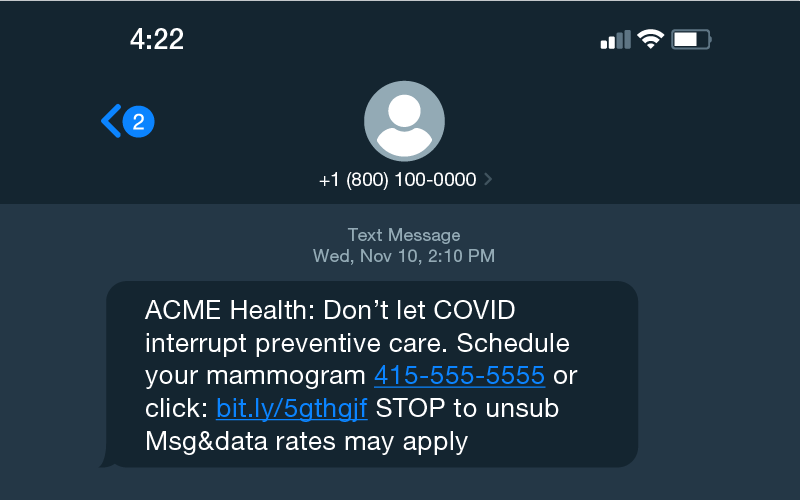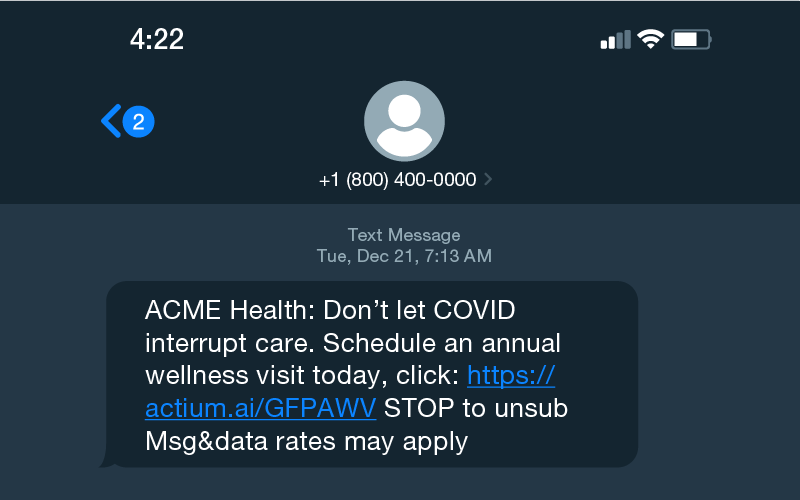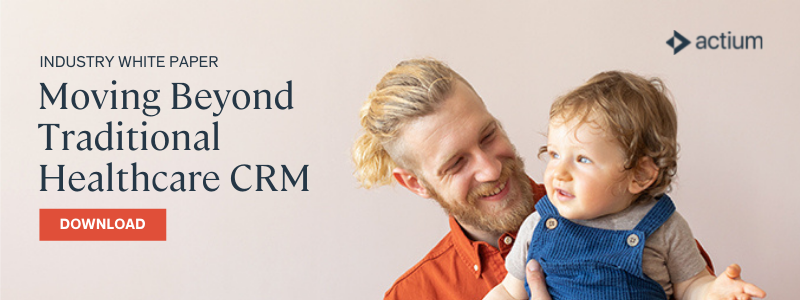How One Healthcare System Used a Technology Tool to Go Beyond Standard Emails for Stronger ROI

When Lara Yahav joined Griffin Faculty Physicians as Director of Specialty and Surgical Practices, she noticed another group using a technology tool with strong outcomes, including results in care gap closure. She realized that tool could take her desire to reach patients and turn it into measurable results, from education to appointments.
We chatted about how Actium Health helps her reach patients and mistake-proof new ideas. (It might be the simplest tech/business partnership you’ll ever read about!).
Q: How did you start using Actium Health’s technologies?
Lara: When I joined Griffin about three years ago, we were mainly using Actium for primary care purposes. I'm on the specialty and surgical side, so I reached out and said, "Hey, I want to get in on this." Someone from Actium gave me an overview of how it worked, and then I asked if we could do something specifically for the specialty and surgical section.
We had an email going out, just a static email talking about a particular topic. Actium helped us embed links that led to a specific web page so we could track what consumers were interested in learning about.
We started with small ideas like that, safe things, trial and error, and we built on it.
Q: Your experience getting started with Actium sounds straightforward and successful. For anyone new to getting started, are there mistakes to avoid in getting started?
Lara: I haven’t made any mistakes, which sounds funny, but it’s because if I ever tried to make a mistake, somebody at Actium stops me. There are times I want to do things that might not be consumer-friendly, and someone from Actium coaches me on that and gives me another approach.
Q: So you started small and grew from there. How does Griffin use Actium Health’s CRM Intelligence product now?
Lara: We use it in multiple ways. On a tactical level, we use it to communicate in newsletters, emails, and texts. On a care level, we use it for care gap closure. From a business perspective, we use it to obtain data on a variety of aspects.
| Examples of Actium Health SMS Outreach | |
 |
 |
Even with all the ways we use it, I think we're still underutilizing it.
Q: How so?
Lara: Well, I think there are probably more capabilities that Actium Health’s product offers. I think we could probably do a little bit more on care gap closure and ensuring our data is all going and coming from the same place.
Q: In terms of driving care gap closures, would you expect Actium to drive that or you as the business owner to drive which ones you want to focus on?
Lara: Actually, one of the things that I like about our relationship is I feel like we help each other. If I have a goal, and this happens quite often, I talk with somebody from Actium, and they help me identify how to execute it with which product. They walk me through the whole process, which makes it simple for me.
Other times, I'll say, "We’re in good shape, we don't need you to do anything," and somebody from Actium will have a suggestion to make a campaign better. One recent example was using a form. I wasn’t going to use one because I thought no one would fill it out. It’s so 1980s! Actium suggested that I try it, and it worked! It turns out people do use forms!
It’s that kind of back-and-forth communication that works really well.
Metrics that Matter: What Do You Track for Care Gap Closure?
Q: What are some of the key metrics you're able to track with Actium’s product that relate to care gap closure and other measures of organizational success?
Lara: We're able to track leakage, the amount of outreach that is being produced from the organization, appointments linked to campaigns — overall success. And of course all the in-between metrics like open rates, click-through-rates, and so forth.
Q: What are the top priority metrics in your job that validate your approach to key stakeholders?
Lara: I feel like that answer changes, depending on the stakeholder. Some of the things that I like and value may not be the same things that translate immediately to goals. For example when we do care gap closure campaigns, we can see the number of individuals who clicked on a link, which means that they've become educated on a particular problem.
And then I love when I'm able to see that they requested an appointment, which means they not only educated themselves, but they also found value in the education and are now advocating for themselves.
I really enjoy those kinds of progress metrics, meaning, what happens on the first push, the second push, and then sometimes we even move it over to an SMS (versus email) to make it even easier for people to either call or complete a form on their smartphones.
I also think identifying opportunities to improve leakage is extremely important as well, as it helps us identify areas where maybe we need to think about adding additional service lines. The data we receive from Actium is very rich.
Q: In that sense, it's almost like an ongoing market research tool?
Lara: Absolutely.
Q: You talked about Actium’s data capabilities earlier. How do you use those in your patient outreach for care gap closure and appointment setting?
Lara: It depends on what we're sending out. Sometimes we do monthly emails that are targeted by gender. Sometimes we do campaigns about our service lines targeted by gender and age. Actually, we do that quite often.
And here’s an example of when I trust Actium: Sometimes I say, "Let's send it to everybody," because I want everybody to be educated on a particular subject, but it's really only applicable to a certain segment of our population. Actium will kind of reign me in in a very nice way.
Partnership
Q: Would you say the way that you operate is reflective across the industry, meaning being receptive to a partnership like the one you have with Actium?
Lara: People in healthcare are receptive because it's a challenging market. One of the things that I hear the most is “if people only knew.” Meaning, if people only knew how easy it was to get an appointment and get this screening done, or if people only knew we had this service line, or if people only knew we existed.
With this tool, people can know, very easily. The return on investment for the email campaigns is about 100% because we already have the email system. Even when we use SMS/text messaging, which has a small cost, the ROI is so worth it. When you can work with a system like Actium’s to use your data and reach out to people, and then track what they do so you can continually refine it and keep educating and making them aware — that is a huge ROI.
How to Get Internal Buy-In to New Tools
Q: Griffin is starting to experiment with SMS. Initially we know there was hesitation. How did you overcome that, and what's the next step with text usage/SMS usage, beyond what you're currently doing?
Lara: I think I might have been the first one, at least on the Griffin faculty physician side, to use text, the SMS. Somebody mentioned it from Actium, and my response was: "I didn't know SMS even meant text."
They showed me how to create the call to action within a character limit. We did a campaign, and it was very successful.
Some people just automatically think email. It could be a cultural thing depending on different age groups; it could be because healthcare is a field that has a lot of information, a lot of explanations, so you don’t think about short-form options like texting when it comes to reaching out to people.
CRM Intelligence vs Traditional Email Marketing
Q: When you talk to peers or someone outside the organization who is not familiar with Actium, how do you describe it?
Lara: I say it’s like an electronic customer retention tool, but you can also use it for data to see how your customers are interacting with the service lines and the content that you're putting out there.
Most people don't know what that means, though! I always say, imagine that you had a platform to communicate to 35,000 of your patients at the same time, and you can make it applicable to different groups, whether it's gender or age or household size or whatever. It’s something that is quite easy to do - you basically don't even really have to do all that much work because you have somebody who specializes in this. All you have to do is share with them what your ideas are, and they help put it together.
That's my main thing that I really love about it. I know a lot of people like the data and all of that fun, like the informatics behind it, but I like the communication component.

Q: What about those who say, "But I do have a platform. We send emails all the time."
Lara: If people say that, I ask if they know how many of their emails are blocked - because the filters are probably going to pick it up as spam based on the large number of recipients.
Also, you usually can't track who opens it. You can't track what they click on. You can't really utilize some of the technology that's out there because you can't embed it in an email.
I have a friend who does exactly that: she sends out emails to her patients through her own email, but she has no idea how many people receive it. I know how many people receive my emails. I know how many people open it, how many people unsubscribe, how many people click on the links, and how many appointments are made from that campaign.
If we resend it, which normally we do because Actium knows the industry standard timeline of waiting between the first campaign to sending out a reblast, you can look at that data set. The reblast only goes out to people who didn't open it, so you're not over-communicating (like many other email systems built for marketing).
The other thing is that the data that you are able to get back from a system like Actium helps you make your campaign or helps drive business decisions.
The Take-Away: Patient Outreach and Care Gap Closure
Q: Final word: what message would you share with your peers about Actium?
Lara: I would share with them the success that I've had and that the organization has had, and the efficiency from cost of the product to staff using the product. Honestly, I would say it's a must-have. I can't imagine ever working at an organization without Actium. I just can't. And nobody's paid me to say this!
To learn more about how health systems are looking to maximize patient activation and lifetime value with AI-powered CRM intelligence tools, download the white paper: Moving Beyond Traditional Healthcare CRM.


